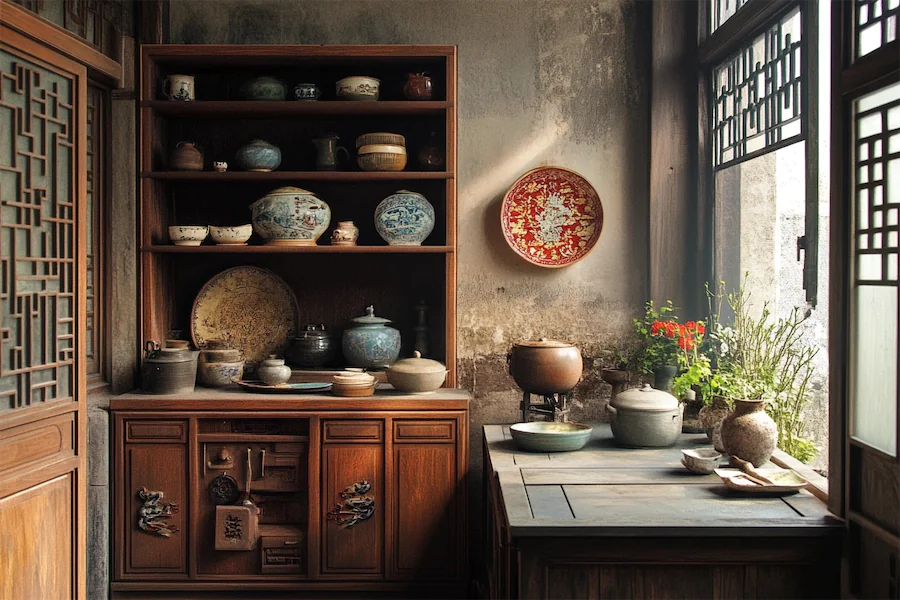A traditional Chinese kitchen reflects the rich cultural heritage and culinary practices of China, emphasizing functionality, harmony, and the use of natural materials. This article explores the key features, applications, and considerations when designing a traditional Chinese kitchen.
Introduction to Traditional Chinese Kitchens
Traditional Chinese kitchens, known as “chúfáng” (厨房), are designed to facilitate the preparation of Chinese cuisine, which often involves techniques like stir-frying, steaming, and boiling. These kitchens are typically equipped with essential tools such as woks, steamer baskets, and large pots. Historically, cooking was done over wood or straw-fueled stoves, requiring skillful control of heat.
Key Features of Traditional Chinese Kitchens
Traditional Chinese kitchens are characterized by several distinctive elements:
- Natural Materials: The use of wood and stone is prevalent, creating a warm and organic atmosphere. Wood is commonly used for structural components and cabinetry, while stone may be utilized for flooring and countertops.
- Cooking Equipment: Essential tools include woks for stir-frying, large pots for boiling, and steamer baskets for preparing a variety of dishes. These utensils are fundamental to traditional Chinese cooking methods.
- Lack of Ovens: Traditional Chinese kitchens typically do not include ovens, as baking is not a common cooking method in Chinese cuisine. Instead, cooking techniques focus on stove-top preparations.
- Efficient Layout: The kitchen layout is designed to enhance workflow efficiency, accommodating the fast-paced cooking techniques prevalent in Chinese cuisine. This often involves a well-organized space where all tools and ingredients are within easy reach.
Applications of Traditional Chinese Kitchens
The timeless design of traditional Chinese kitchens can be adapted to various settings:
- Cultural Preservation: Restoring or maintaining traditional Chinese kitchens in historical homes to preserve cultural heritage and architectural integrity. This involves using authentic materials and designs that reflect historical accuracy.
- Modern Residences: Incorporating traditional Chinese elements into contemporary homes to blend cultural aesthetics with modern functionality, creating a unique and harmonious living space. This fusion can result in a kitchen that honors tradition while meeting today’s needs.
- Themed Restaurants: Designing kitchens in Chinese restaurants that reflect traditional architecture to provide an authentic culinary experience for patrons. Such designs can enhance the dining atmosphere and connect guests with Chinese culture.
Considerations When Designing a Traditional Chinese Kitchen
When planning a traditional Chinese kitchen, consider the following:
- Material Selection: Choose authentic, natural materials that align with traditional Chinese construction to maintain cultural authenticity and environmental harmony. This includes selecting appropriate woods and stones that were historically used.
- Integration of Modern Amenities: While preserving traditional aesthetics, ensure the kitchen meets contemporary standards of functionality and convenience, such as incorporating modern appliances discreetly. This balance allows for traditional design without sacrificing modern comforts.
- Spatial Layout: Design the kitchen to facilitate efficient workflow while maintaining the open and airy qualities characteristic of traditional Chinese architecture. Consider the placement of cooking stations, preparation areas, and storage to optimize functionality.
- Cultural Sensitivity: Respect the historical and cultural significance of traditional Chinese design principles, ensuring that adaptations honor traditional architecture and practices. This involves understanding and implementing design elements that are culturally meaningful.
Conclusion
A traditional Chinese kitchen offers a harmonious blend of cultural heritage, natural materials, and functional design. By embracing the principles of traditional Chinese architecture and culinary practices, one can create a kitchen space that is both culturally rich and practically efficient, reflecting the timeless beauty of Chinese heritage.
